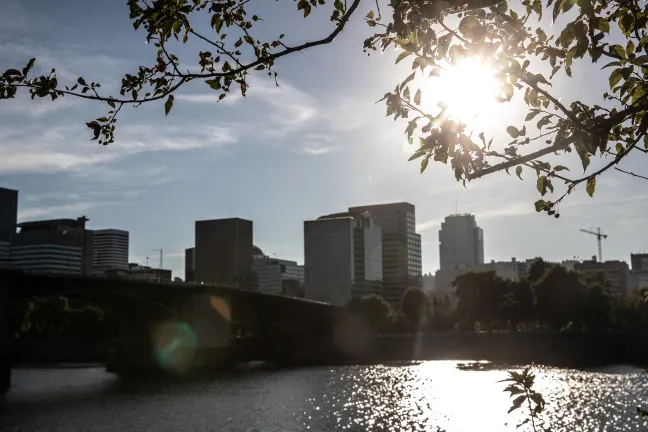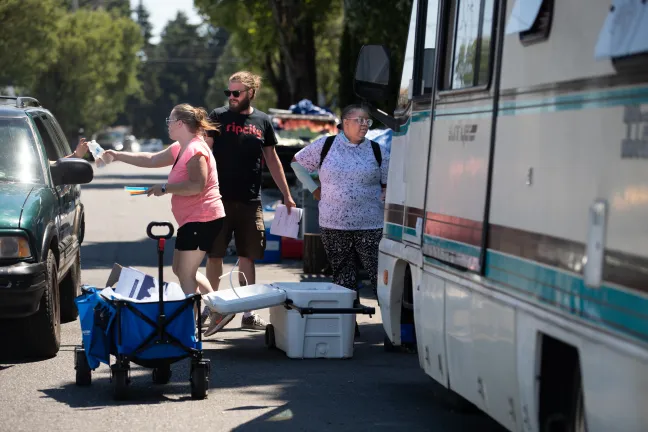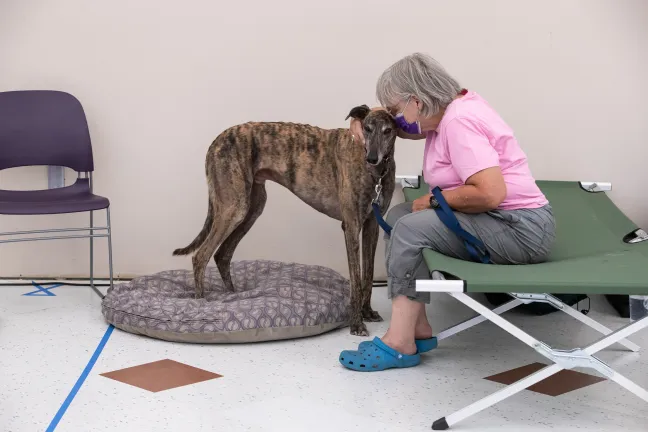Multnomah County has teamed with the City of Portland and a host of nonprofits and health systems to prepare the community early for the eventual return of deadly summer heat.
Residents will notice early education and outreach this year, especially among people at particular risk during hot weather, as well as plans for a larger network of neighborhood cooling centers ready to open when temperatures soar.
“Based on our experience last summer and after multiple winter responses, we feel more prepared going into this summer,” said Jenny Carver, an emergency manager with the Department of County Human Services.
The County extracted key lessons from its hot- and cold-weather emergency responses over the past year. They include:
- Prepare vulnerable people ahead of time with early health and safety messages, especially people living alone.
- Make services and resources more available to people who cannot, or choose not, to go to a cooling center.
- Plan for smaller-scale cooling centers, which are perceived as more comfortable and report fewer conflicts than larger-scale sites.
- Continue to disperse cooling centers broadly across the County to make them more accessible.
- Inform people who rely on public transit and who can't afford the fare that they can trust that public transit will take them to a cooling center.
- Continue to allow pets in cool spaces, an offering that is critical to support people who otherwise would not come to a cool space because they do not want to leave their animals behind.
“We have listened to community members, built emergency management infrastructure, trained staff and invested dollars to be better prepared,’’ said Chair Deborah Kafoury. “We are in a better position to help our community successfully face the next severe weather crisis and to begin to build climate resilience.’’
Last year, the region experienced record-shattering heat that, by the end of summer, had killed 72 people in Multnomah County. A final report being released June 26 details the causes and conditions of those deaths.
- All but three of those 72 deaths resulted from high temperatures during the last week of June.
- That same week, deaths from all causes were double the normal level.
- Heat-related emergency department and urgent care visits in 2021 were three times higher than during a typical year.
- The people most vulnerable during that event were people who lived alone and in multifamily buildings, people in warmer parts of the county or who were experiencing homelessness or unstable housing. Fewer than 10% of those who died had air conditioning.
“We talk about the June 2021 heat dome being an anomaly, but with climate change we must assume life-threatening extreme heat will be the new normal,’’ said Multnomah County Health Officer Dr. Jennifer Vines. “And we have to plan for that.’’
Early preparedness
Multnomah County’s Environmental Health staff has been working with the City’s Neighborhood Emergency Teams to conduct direct outreach to residents. They have identified 300 multifamily buildings in urban heat islands where they will be able to reach lower-income people who are seniors or people of color and share information and resources on preparing for heat
Starting this month, direct services providers from across the County will also begin reaching out to vulnerable clients to discuss ways to get ready for and stay safe during dangerous heat.
And the county’s liaison leadership will share hot weather communications with a network of thousands of faith communities, culturally-specific nonprofits, businesses, schools and daycares, event venues and organizers, low-income and residential housing managers, and homeless service providers.
The County will also consider, with its City of Portland partner, using a wireless emergency alert for heat. Last year, the County sent the three alerts to almost all mobile numbers in the area to warn residents of dangerous heat and help prevent visits to overwhelmed hospitals dealing with the Delta variant surge. People interested in opting into alerts should sign up for the Public Alert system.
The Joint Office of Homeless Services has already purchased its initial stock of hot-weather supplies — including 30,000 packets of sunscreen, 50,000 cooling towels and 100,000 electrolyte hydration packets. The Joint Office has already begun assembling the kits, which are distributed — along with water and additional information about cooling centers and shelters – by outreach teams, mutual aid groups and even some volunteers who crisscross the County.
The Joint Office relies on warehouse storage space and a bustling distribution center in downtown Portland to manage outreach supplies and stay prepared for weather emergencies, before they arrive, any time of the year.
“We have begun assembling those kits so when the heat hits, we’ll be ready to deliver those,” said Celeste Duvall, emergency planner for the Joint Office.
This month, the County’s health and human services programs will begin delivering cooling kits, fans, air conditioning units and portable heat pumps to low-income clients living in urban heat islands. The deliveries are focused on people with intellectual and developmental disabilities, families with young children, and seniors who are unable to purchase supplies of their own.
Cooling centers in 2022
In June 2021, Multnomah County opened three large 24-hour cooling centers in response to record-breaking heat. More than 1,400 people sought relief over five nights. It was the first time temperatures had risen to a point where the County stood up 24-hour cooling centers.
Two months later when temperatures topped 100°F, the County quickly opened four shelters and issued an emergency alert that went to every cell phone in the county.
Heading into this summer the County has identified 18 buildings — both smaller and more geographically dispersed— that can be used for cooling space if a heat event occurs. The facilities have already been surveyed and many permitted, allowing the County to open 24-hour cooling centers quickly as needed.
Multnomah County Emergency Management, meanwhile, has a new and larger warehouse allowing for the storage of more shelter supplies. The 14,000-square-foot space holds 1,700 sleeping cots and mats, 17,000 blankets, 44,000-square-feet of floor covering and 4 trailers ready to load for delivery to cooling centers.
And the County has received agreement from TriMet that, any time the County declares a state of emergency, TriMet will transport people to shelters and waive fares when riders can’t afford to pay.
The County will consider several factors when determining whether to open cooling centers. Those include
- Daytime maximum temperatures and the duration of those highs
- Nighttime minimum temperatures, which can allow people to recover and homes to air out.
- How early in the season hot weather occurs. “We know early season events are more severe because bodies have not yet acclimated,” said Brendon Haggerty with the Healthy Homes program in Environmental Health.
- Overlapping hazards. The County is also considering how to respond if more than one hazard is present and may dictate a more aggressive response. For example, the County opened four cooling centers during a heat wave last August. The decision was made in part to keep people from seeking care in hospitals that were already full.
Bookmark and Prepare
Bookmark these links!
- Help for When it's Hot: Latest information on cooling centers, health and safety.
- 2-1-1 info: Call to find the cooling center nearest you, and for transportation support.
- Public Alerts: Sign up to receive health and safety alerts in your area.
- National Weather Service: Check the forecast and plan outdoor activities for coolest times of day.
- Heat Risk Map: National Weather Service map forecasts heat risk for vulnerable populations.
Reach out for help
Aging and Disability Resource Connection: 24-hour information and assistance to older people, people with disabilities and caregivers. Call 503-988-3646 or email adrc@multco.us.
Weatherization: Multnomah County helps people save money on their energy bill and improve their indoor air quality. Services are free to homeowners who meet their income eligibility requirements.
PGE Bill Discounts: Portland General Electric offers an Income-Qualified Discount Program, providing monthly discounts between 15% and 25%. No financial documents are required to apply, just household size and average gross annual household income. Apply online or call at 503-228-6322.
OHP heat help: Individuals on the Oregon Health Plan with health conditions exacerbated may be eligible for “health-related services” such as air conditioners. Members interested in seeing if they qualify for support should reach out to their health plan.
Heat week events
Community partners and regional governments have joined together to host the region’s first annual “Heat Week” running June 24 through June 30. Attend an in-person or virtual event on a range of heat- and climate-related topics.
- Sunday, June 26: Kick-Off event and memorial featuring health experts, elected officials and presenters. Noon to 5 p.m.at the Leach Botanical Garden, 6704 SE 122nd Ave., in Portland.
- Monday, June 27: Virtual panel featuring experts on climate & mental health
- Tuesday, June 28: Climate Resilience Pedalpalooza Ride 5 p.m. Lents Park to Colonel Sumner Park
- Wednesday, June 29: Heat first aid training, offered virtually by the Portland Bureau of Emergency Management.



